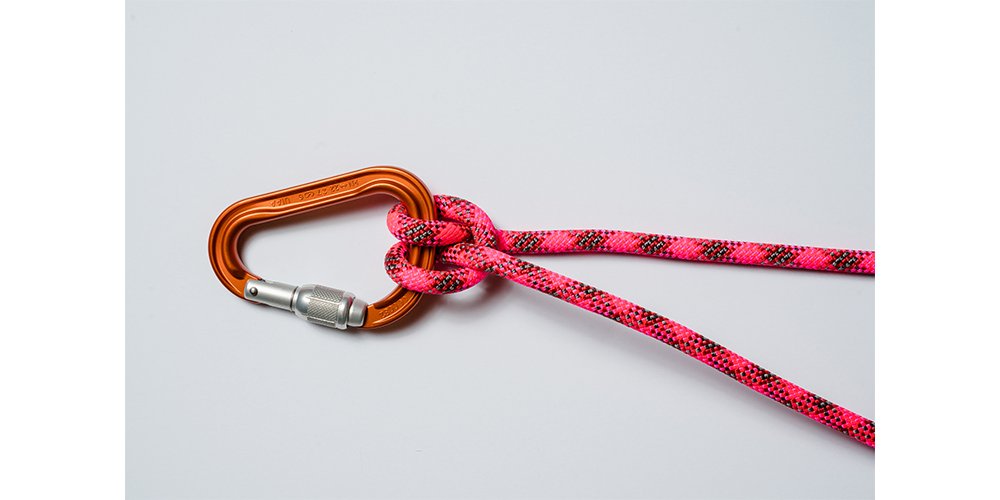The Seven Need-to-Know Climbing Knots
Learn the Seven Knots That Every Climber Needs to Know
If you’re going to be a rock climber, you don’t necessarily need to know how to tie your shoes (as long as you wear Velcro slippers), but there are seven essential knots you’ll want to know. There are dozens of knots that might be worth learning as a climber, but for the most part, you can get up and down any climb on Earth with just these basic, essential knots—The Figure-8 Retraced, Girth Hitch, Clove Hitch, Munter Hitch, Double Fisherman’s, Prusik and Euro Death Knot.
Know them, learn them, and practice them until you can tie them in your sleep.
Euro Death Knot
What is it: A knot used for joining two climbing ropes together for a rappel. The Offset Water Knot, otherwise known to climbers by the misleading (and inaccurate) name of “Euro Death Knot” (EDK), is the best knot for joining two ropes together for a rappel.
Why it’s cool: Easy to tie. Easy to untie. Less likely to get hung up on rock features during rappels.
Red Flags/Rules: Leave at least 8 to 12 inches of tail.
Figure 8 Retraced
Girth Hitch
What is it: A knot for tying climbing slings to various features including: the belay loop of your harness, bolt hangers at anchors, and “threads” of rock, horns/chicken heads on trad routes.
Why it’s cool: Easy to tie, can be tied with one hand, and is useful in many situations.
Red Flags/Rules: Don’t leave slings girth-hitched to your harness belay loop for extended periods of time.
Clove Hitch
What is it: A knot for quickly tying a climbing rope to a carabiner. Great for tying yourself in to an anchor. Also the clove hitch is especially handy when equalizing an anchor using the rope.
Why it’s cool: Easy to tie and untie after being weighted. Easy to adjust after being tied. Can be tied with one hand, allowing you to quickly clip to an anchor or bolt.
Red Flags/Rules: At a certain force, clove hitches will begin to slip, which is why they aren’t recommended as the sole knot for tying yourself into an anchor, and they are best paired with another knot such as a Figure-8 on a bite. However, it’s virtually impossible to ever generate a large-enough and consistent-enough force to cause the clove hitch to slip in a dangerous way.
Munter Hitch
What is it: A knot that allows you to belay or rappel on a rope with nothing more than a single locking carabiner.
Why it’s cool: This knot could save you if you drop your standard belay/rappel device.
Red Flags/Rules: Not recommended for anything other than emergency use. The Munter Hitch severely kinks the rope, especially in a rappel.
Prusik
What is it: A way to attach a piece of cord to a (thicker) climbing rope. The main use is to back up your rappel device (not covered in article). You can also use a prusik as a way to ascend a rope (if you don’t have a mechanical ascender). There are also a multitude of uses for self-rescue and escaping belays.
Why it’s cool: Easy to tie and untie, and may come in handy more than you’d think. With two prusiks, you can ascend a fixed line, potentially getting yourself out of a pickle.
Red Flags/Rules: Make sure the loops/coils are neat.
Double Fisherman’s
What is it: A knot used for tying two ends of a cord or rope together. Use this knot to create a cordellette (a piece of cord tied into a loop) or to create a prusik.
Why it’s cool: Reliable, safe knot for joining two ends of a rope or cord together.
Red Flags/Rules: This knot will weld itself shut over time, effectively making it impossible to untie. This knot is only to be used for joining two pieces of rope or cord. To join two pieces of tubular webbing, use a water knot (not covered here).
Now that you’re familiar with the climbing knots all climbers need to know, you’re ready to get climbing. Got questions about climbing gear or need some beta on the best places to climb in your area? Chat with our Gearheads or shop our climbing essentials below.






